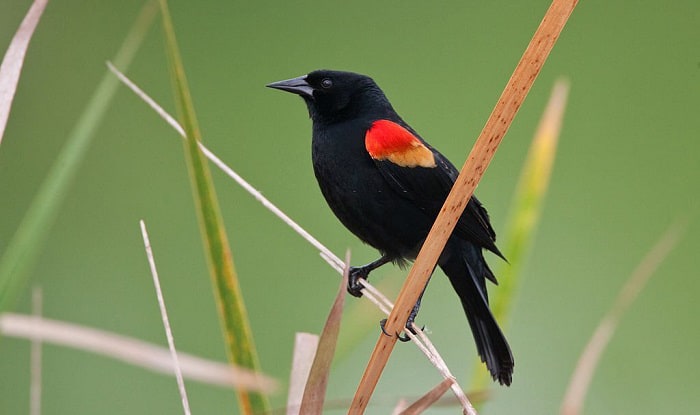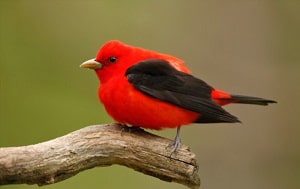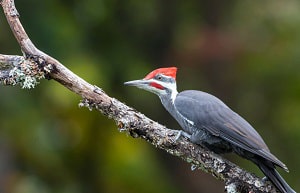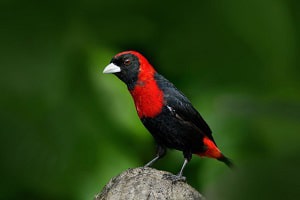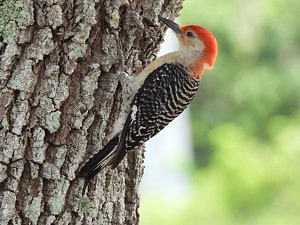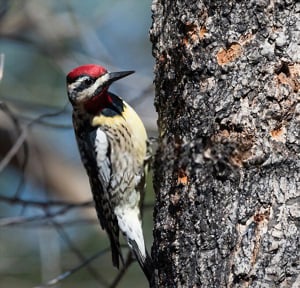There are thousands of bird species in the world, and a few have the same shade combination. Particularly, in North America, you can find 10 birds that are red and black. The list includes the scarlet tanager, cardinals, vermilion flycatchers, woodpeckers, and more.
These birds have red and black hues in some parts of their body. And they definitely look good. In this post, we’ll get to know these adorable bird species. Knowing them will allow you to identify them.
Table of Contents
Important Information About Red and Black Birds
In North America, you can see large black bird with redhead or red wings, birds with red bodies and black heads, and various combinations of red and black. Let’s discover interesting facts about these avians.
1. Scarlet Tanager
The scarlet tanager is a stout north American bird with red back and black wings. This avian species builds its nests in mature huge trees found in deciduous and alpine woodlands.
They are migratory birds that love insects, but can thrive also on fruits and flowers. Additionally, this kind of bird is protective of their breeding grounds.
Facts About The Scarlet Tanager
As a small and stocky bird, the scarlet tanager has amazing facts that you’ll be interested in.
- They have one brood per year, with a clutch of 3-5 bluish eggs. Scarlet tanagers incubate their eggs for two weeks, with a nesting period of up to 15 days.
- These birds can fly for miles, and they’re excellent fliers. Once winter is over, they go home to breed. Each year, the scarlet tanagers have different mates.
- There are approximately 2.6 million scarlet tanagers in the world. The good news is they’re not in any danger of extinction.
2. Northern Cardinal
Red and black birds like the northern cardinals are absolutely attractive. This songbird species sings very well, and both sexes do so, unlike other breeds where only the males sing the most. They live in shrubberies and nest in tree branches.
Northern cardinal females lay 2-5 eggs, incubate them for 11-13 days, and repeat the process one more time before the year ends.
Facts About The Northern Cardinal
The northern cardinal is a popular bird, mostly because seven states proclaimed this avian as their state bird. These states are North Carolina, Illinois, Ohio, Indiana, West Virginia, Kentucky, and Virginia.
- This specific bird species acquires its vivid crimson plumage from the carotenoid found in their food choices. When there’s scarcity of this substance, their color fades a bit.
- Northern cardinals are monogamous, not just for one breeding season, but for life. Males and females work together to build their nest, protect their family, and feed their young.
- As summer is ending, this bird species may go through a molting process. And then new feathers start to grow.
3. Vermilion Flycatcher
A vermilion flycatcher is a bright red bird with black wings that weighs 11-14 grams and measures 13-14 centimeters. This insectivorous species loves open places, and they prefer to nest in a leaf-free tree branch. Their population is at fifteen million, and their conservation status is not threatened.
Facts About The Vermilion Flycatcher
Vermilion flycatchers like to spend their time alone or with a friend. Their mating months are March-July and October-January. Let’s check out other facts about this bird species.
- During the courtship process, the males woo their prospect mates by giving them a butterfly or other food.
- Vermilion flycatchers have two broods a year, with 2-4 eggs for each nesting period. The creamy or white blotched eggs are incubated for up to 15 days.
- They use their wings to catch flying insects while in the air and feed on them. This bird breed hunts for food fast and eats them in the same place they fly from.
4. Tricolored Blackbird
There are many types of red birds, and the tricolored blackbird belongs to the list thanks to the obvious red patch on their wings. This avian species starts a family in wetlands as well as searches for food in these places. And in the breeding season, they build a colony.
Facts About The Tricolored Blackbird
As extremely social avians, tricolored blackbirds stay in large flocks while searching for food. Their wingspan measures at 35.5 centimeters, and they’re 22.2 centimeters long with a weight of 59.5 grams. Plus, they like mingling with other blackbird species.
- They like to feed on insects, grains, and seeds. Their sharp beak allows them to forage for food in thick grasses.
- During the breeding season, tricolored blackbirds have two broods, 3-4 bluish eggs with reddish markings, and an incubation time of two weeks.
- The population of this bird breed is decreasing. Currently, there are only 300,000 tricolored blackbirds on the globe.
5. Pileated Woodpecker
The pileated woodpecker is large at 16-19 inches. They nest in huge trees, where they dig holes using their sturdy bills. The unique body shape and color of this bird makes them distinguishable. They have a vivid crimson head, black throat, and white side lines.
Facts About The Pileated Woodpecker
This bird species thrives in open pine woodlands. As woodpeckers, they drum on large trees to establish their territory.
- The noisy and far-reaching call of the pileated woodpeckers sounds like “kuk-kuk-kuk”.
- They like to feed on carpenter ants, fruits, beetles, and nuts. With the use of their bills, they ransack ant colonies, and their long tongues scoop up ants.
- Male and female birds take turns incubating their 2-4 eggs. And after 14 days, both parents get to see their baby birds.
6. Red-winged Blackbird
The red-winged blackbird is one of the birds with red in their name, and they live in wetlands. Males and females differ slightly in color. The former has a black body with yellow and red shoulders, while the latter has a paler color. Their bird calls include “oak-a-lee,” “cheer,” and “chek.”
Facts About The Red-winged Blackbird
Red-winged blackbirds prefer to feed on insects, grains, and seeds. Males are known to be aggressive during the mating season and safeguard their nesting territory.
Other facts include:
- There are up to 4 blotched and bluish eggs in each clutch, which are incubated for 11 days. After two weeks, the young avians leave their nests.
- Male red-winged blackbirds will never be accused of being monogamous. They have up to 15 female mates in one breeding season.
- This bird breed has an average lifespan of two years. But one avian survived for almost 16 years.
7. Masked Crimson Tanager
Coming from the family of Thraupidae, the masked crimson tanager is a red bird with black wings and black mask. This avian species is found in tropical regions. They used to be part of the crimson-backed tanager breed, but 800,000 years prior, the masked crimson tanager became their own species.
Facts About The Masked Crimson Tanager
Masked crimson tanagers are known as both insectivorous and frugivorous and are found in Peru, Ecuador, Colombia, Brazil, and Bolivia. Their conservation status is stable, so no need to worry about extinction.
- This bird is 7-7.5 inches long, has a silver bill, and looks similar to the vermilion tanagers.
- The high-pitched call of the masked crimson tanager sounds like tchlink or “tink”, and they love to sing before the sun rises.
- This avian species practices cooperative breeding. It means that all members of a colony take part in caring for the baby birds.
8. Crimson-collared Tanager
The crimson-collared tanager is a small black bird with red head. This species lives in humid woodlands, and they build their nests in trees. And in each breeding season, females lay two light blue and spotted eggs.
Facts About The Crimson-collared Tanager
Let’s explore a few facts about this bird species.
- This small songbird has a length of 7.5-8 inches, with a light blue beak, red tail, and bluish grey legs.
- The high-pitched songs and calls of the crimson-collared tanagers include “ssi-p”, “tewee”, “tueee-teew”, and “chu-chee-wee-chu”.
9. Red-bellied Woodpecker
The red-bellied woodpecker is a black white and red bird that lives in woodlands and wetlands. Their diet includes invertebrates, insects, small avians, berries, bird eggs, fish, fruits, and frogs.
And in bird feeders, they love to eat suet and black oil sunflower seeds.
Facts About The Red-bellied Woodpecker
Red-bellied woodpeckers are non-migratory birds. During the nesting season, nest building is done by both pairs, especially by the males. They have up to three broods annually.
- Birders can tell a male from a female through the absence of red on the latter’s crown. Only the males have a red crown and neck.
- Though named as red-bellied woodpeckers, the crimson shade on their stomach is barely visible.
10. Yellow-bellied Sapsucker
The yellow-bellied sapsucker is not a red bird with black head, but rather a black avian with a distinctive red head. They can be unfriendly to humans. This bird species weighs 35-62 grams and is 7.5-8.3 inches long. And their color combination includes black, red, white, and yellow.
Facts About The Yellow-bellied Sapsucker
Yellow-bellied sapsuckers rely on sap for food and sustenance.
- This species use their beaks to create tree cavities for nesting and roosting purposes. These small cavities are called “sapwells”. And after they abandon the holes, other birds take over.
- Males and females share the responsibility of building nests and incubating the eggs. Males often feed their baby birds.
- Yellow-bellied sapsuckers are also known as morse code birds. They tap and drum on trees in a unique manner.
Conclusion
In this post, we featured ten amazing birds that are red and black. Though similar in body color combination, each of the birds has its own characteristics. These avian species are fascinating, especially when you get to know them.
We hope you enjoyed reading this article. Now, when you see one of these birds, you will no longer get confused in naming them. And if you have any questions or new ideas, kindly share them with us. And please help us spread this post to social media.

George and I became friends after a birdwatching trip with our new group. And we have been enjoying every adventure together. When he told me the idea of establishing a site that shares our experiences and fun, I immediately agreed. After trials and errors, here we have Thayerbirding.


